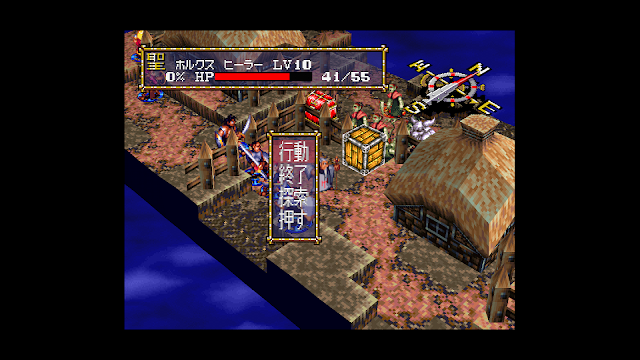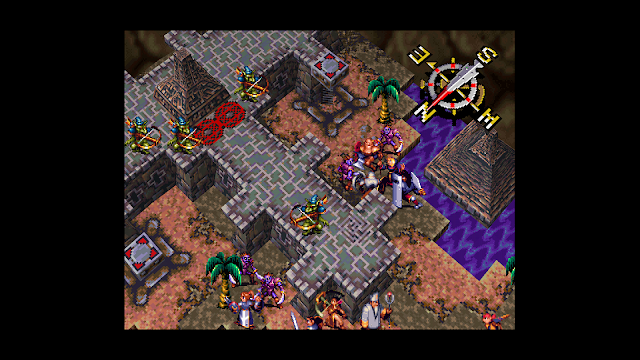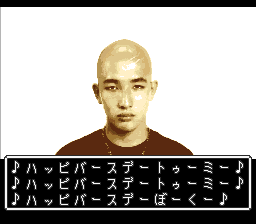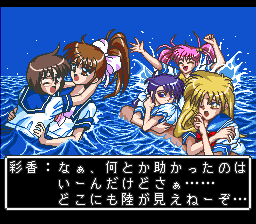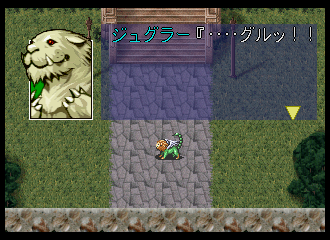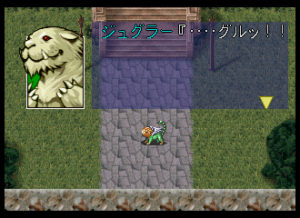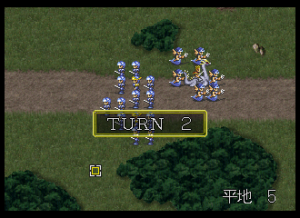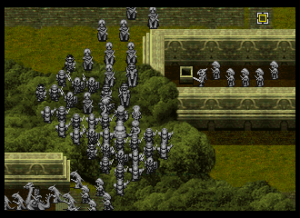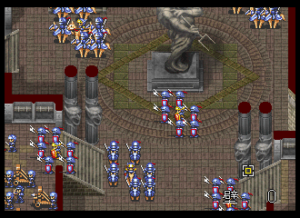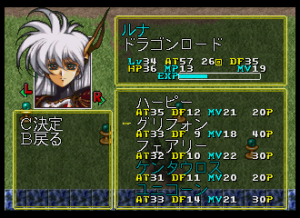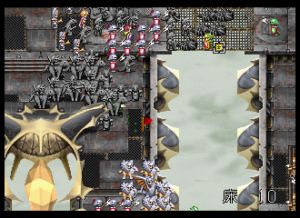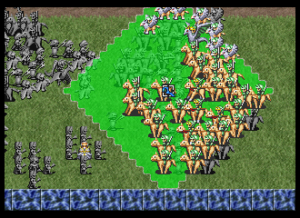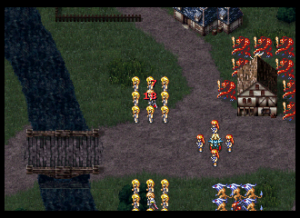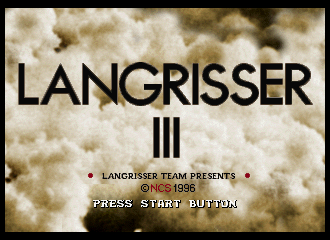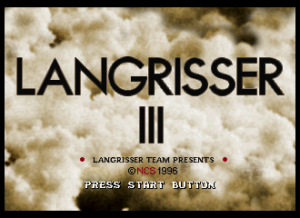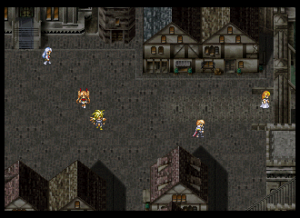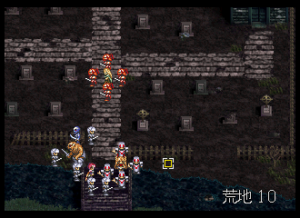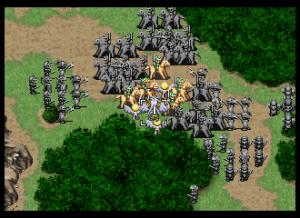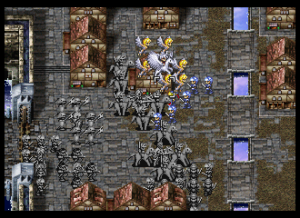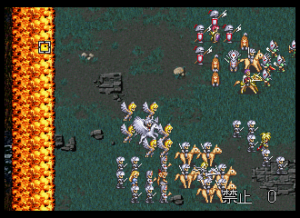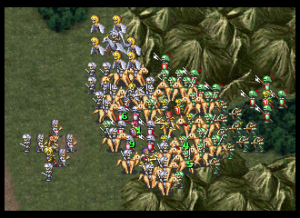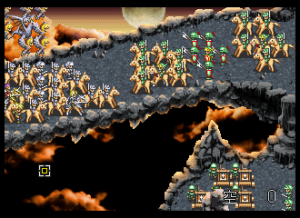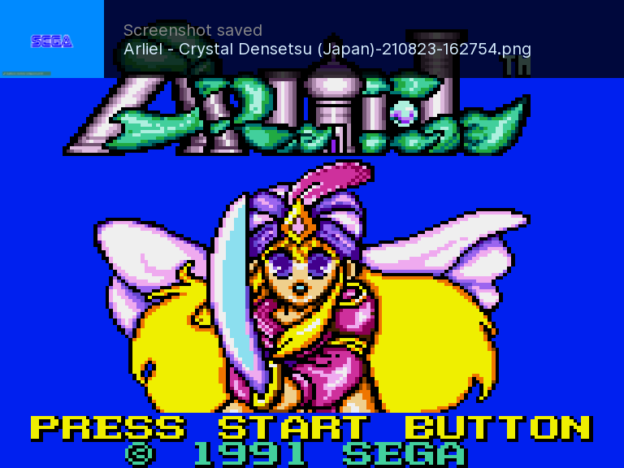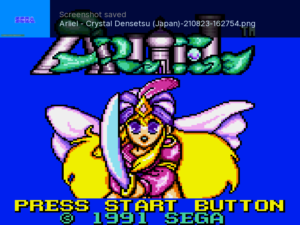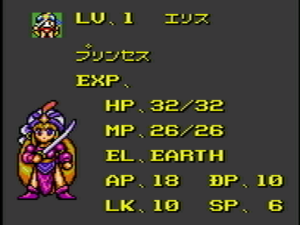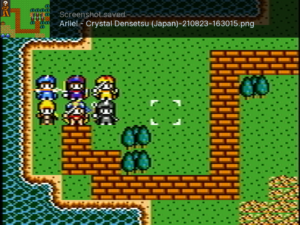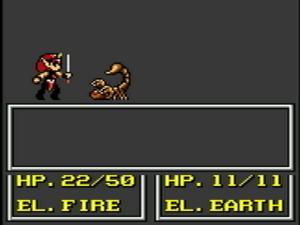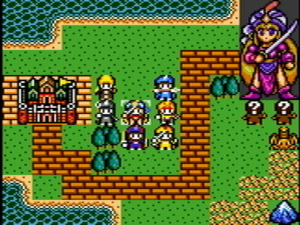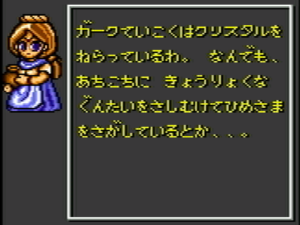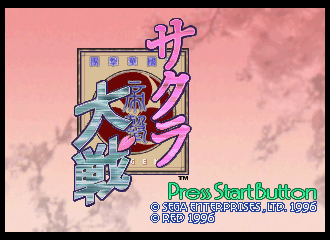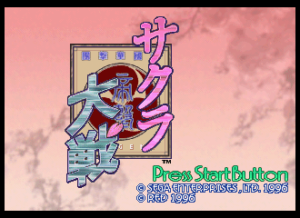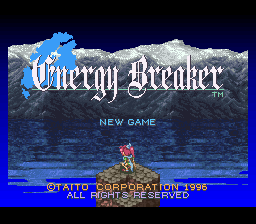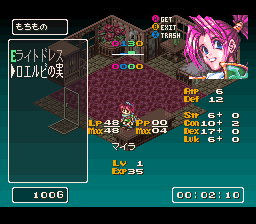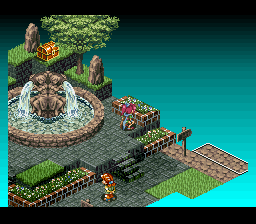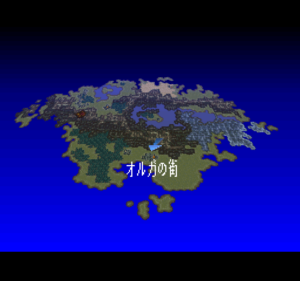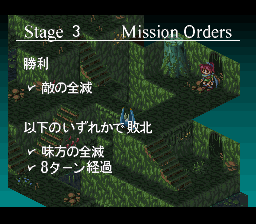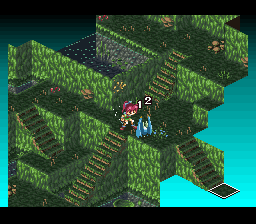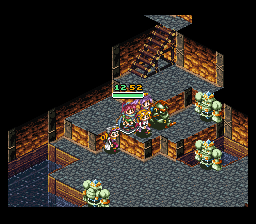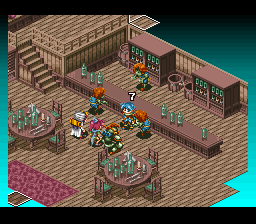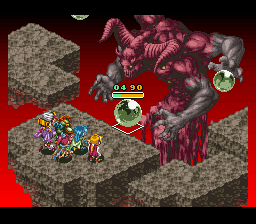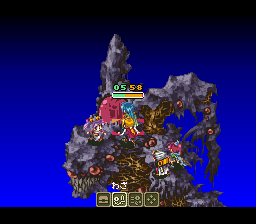Sakura Taisen (サクラ大戦), Saturn
Released 9/27/1996, developed and published by Sega
This game is not an SRPG; it’s really a visual novel with tactical battles. The tactical battles aren’t just fluff — while the system is not as developed as some of the SRPGs I’ve played up to now, it’s not as bare bones as something like Farland Story. Where this game fails in my criteria is that the characters cannot be developed in any way; you can get them some stat bonuses for each chapter but the bonuses go away at the end of the chapter. However, I’m going to play the game anyway. I’ve always been interested in the series and several friends of mine are big fans of it, so this seems like a good time to play it.
I could have played the PS2 remake but I decided to go for the original instead. My general view of remakes is that especially with a series like Sakura Taisen, I want to see how the series develops. The PS2 remake was released after Sakura Taisen 4 and probably incorporates a lot of the developments in the series that were made in the three sequels.
The setting is the Taisho period, but a cyberpunk version of it with a lot of steam engine technology (that gets pretty ridiculous at some points). The setting is inspired by various stage drama, particularly the all-female Takarazuka Revue and kabuki. The main characters are actors in a troupe that seems a lot like Takarazuka. The presentation is similar to an anime, with a fair amount of FMV videos, and each chapter ending with a “next episode preview” narrated by one of the characters.
The character designs are by Kosuke Fujishima, at the time a major manga-ka known for Ah! My Goddess. He had designed the characters for Tales of Phantasia the same year, but in this format they could directly translate his character designs to the game itself rather than just having them appear in the instruction manual.
The story involves Ogami Ichiro, who is assigned to be the captain of the Imperial Attack Squad, which moonlights as the Imperial Stage Revue (pronounced the same way) — this has elements of magical girl anime in it, and I wonder if the popularity of Sailor Moon (which was running its final season when this game came out) had an influence. Tomozawa Michie, who played Sailor Mars, does the voice for one of the game’s characters.
The majority of the game is reading text (and listening to the voice acting for some of it), so it will not appeal to everyone. The general flow of the chapters is you have long sections of dialogue, with some choices. The LIPS system requires you to choose your choices in a limited time, or you can wait for the time to run out and then your character will stay silent. By choosing various options you affect the girls’ trust in you, which raises their stats for the battles. You can also have some free exploration points where you can go to various rooms and talk to the girls, although it’s a bit annoying that you can’t see who is where (so sometimes you waste all your free time going to places where nobody is). The trust values reset at the beginning of each chapter (and can never go below 0), but there’s also a hidden “love” stat that accumulates throughout the game and affects the later chapters.

Eventually there will be a battle (some chapters have just one, some have more than one). The battles are basic tactical combat style. Each character can take two actions a turn, although you can’t use two attack or two defense actions. In addition to move, you have basic attack and special attack, and then defend, heal, and build power. To use the special attacks you need a full power gauge, which goes up when you get damaged or when you use the build power command. Finally, Ogami has a “cover” skill which will negate all the damage to a girl from one attack (can be done 8 times per battle). Each girl has their own type of attack:
- Sakura is just a 1 range basic attack.
- Maria has a longer range gun attack (but only in straight lines)
- Sumire has a 2-range halberd (which can attack two enemies at once)
- Koran has a range attack that isn’t limited to straight lines and affects a 1-radius area
- Kanna is just a 1 range basic attack
- Iris attacks all the enemies in a 2 radius range from her mech.
There are also some supporting characters like Ayame and Yoneda the commanders.
The battles on the whole are not very difficult, but they require enough skill and thought that they don’t feel like they were just slapped into the game. The lack of real advancement or learning new skills is a bit of a letdown but overall I thought this was a decent battle system for the game.
This game has a patch, and the patch actually subtitles the FMVs — I guess they’re stored on the disc in a format that makes this possible. So check it out!
Now a brief chapter runthrough:
Chapter 1
Ogami joins the squad and learns about the secret mechs! They run off psychic power, so all the people are in the squad because they have the power necessary to operate the units.
The enemy is Tenkai, who wants to use magical power to restore the Tokugawa Shogunate and send all the foreign stuff away. He has four underlings, and you fight one of them (Satan) here. This is an introductory battle so it’s even easier than most of the already easy battles. The standard tactic against the bosses is to attack normally until their power gauge is almost full and then unleash all your special moves.
I did not use a walkthrough, so I just picked whatever options in the dialogue sections seemed good to me throughout the game. A few times I restarted from my last save when it was pretty obvious I had picked bad choices, but I feel like the game would not be impossible even if you picked all the worst choices in every dialogue.
Chapter 2
Koran joins here. The battle introduces missile shooters that can target your guys from far away, so you have to be careful to avoid them.
Chapter 3
And now we get Kanna. This is vs Setsuna, one of Tenkai’s other followers. The next few episodes follow a typical anime trope where each chapter focuses on the backstory of one (or two) of the girls. In this case it’s Maria, who was a fighter in the Russian Revolution (so this must take place in the later part of the Taisho period, early 1920s?).
You have two paths to reach the end — I took the longer path because it looked safer, but I was probably too much of a scaredy-cat. Losing one person lowers your relationship with them so it’s good to keep everyone alive, but there’s no other drawback.
One other thing you start encountering is minigames — each girl has one. You can play all of them when you beat the game, otherwise they’re only available in certain short periods. Koran plays Hanafuda with you, and Maria makes you remember instructions to make a stew, and so on.
Chapter 4
This episode focuses on Iris, whose psychic power goes haywire at a scary movie. She then starts to believe that no one in the group cares about her. (She also destroyed the whole movie theater and some things around it; that must cost a lot of repair money…)
The fight is against Rasetsu, who has an annoying power to teleport people around, which makes it rough to fight him. But you can take him down with the same basic tactics.
Chapter 5
This chapter focuses on Kanna and Sumire, who are the classic “don’t get along but also seem like friends” characters. You have to investigate a haunted mansion — I found this part rather annoying because you have to keep investigating empty rooms over and over again with no indication of where you should go next, and I think the “repetition for comic effect” would have worked better as an 8 minute segment of an anime episode rather than something that can take an hour to work through.
The battle is against Miroku, another one of Tenkai’s underlings. It’s a long stage because you have to climb a cliff area with a lot of those missile launchers. Miroku herself is just another basic boss strategy.
Chapter 6
This one is Sakura-themed. Everyone is preparing for a party, but Sakura doesn’t return from buying snacks. She and Ogami get trapped underground and we see Sakura’s psychic power go into overdrive to save them both. Meanwhile, Tenkai has finished setting up the magic areas that will let him attack Tokyo in full force.
The fight is against Miroku again. This is an indoor map where you have to open doors (although apparently you can defeat Miroku through the wall without going into her room; I didn’t realize this).
Chapter 7
This is the last stage of Disc 1, so obviously not the end of the game — once again this is patterned on a pretty common anime trope where the first major enemy is not the true final power. The goal here is to beat Tenkai. The stage has several battles, and you have to beat Tenkai twice. I didn’t find that the exact same tactic worked on Tenkai as the other bosses, but with judicious use of Ogami’s block skill you can make Tenkai’s super attacks much less scary.
Chapter 8
Several months pass, and it’s New Year’s. The main enemy is now Satan, who was the underling of Tenkai but now takes center stage with his own underlings. The plot also goes off into bizarre areas — I have to say I didn’t like this part as well as the first one. I liked the “restore the Edo Bakufu” of the first part; it seemed to fit in really well with the overall theme. But here it turns out that Satan is literal Satan (the Devil), and the Archangel Michael appears as well.
First, there’s a date with the girl that you have the highest love rating with. For me it was Sakura. I wonder if that’s just the natural result if you don’t specifically try for one of the other girls.
There are three battles in this chapter (the last three chapters are all longer than the first ones). In the first one you mostly get your butt kicked until the ship comes in and saves you — this is an excuse to destroy all your mechs so that you can get more powerful ones. Unfortunately that makes no real gameplay difference, but it fits with the usual powerups in mech and magical girl anime.
The second fight is against Inoshishi, one of the followers of Satan.
Chapter 9
Satan is trying to revive the Seima Castle in Tokyo Bay. This stage also has several battles. In the first one you are trying to prevent the enemies from entering the base, while also having to destroy some machines that are making additional enemies. Despite the difficult sounding goals, I didn’t find it too hard.
The second fight is against Cho, another underling.
Chapter 10
Final stage, as we attack the Seima Castle. There’s a new battleship — the technology gets kind of ridiculous here but I guess it’s part of the anime/cyberpunk theme. All the bosses revive, and the first section is devoted to killing off the entire party (I have a feeling this was directly inspired by the end of Sailor Moon’s first season). However, Archangel Michael revives them all so it’s fine.
The final boss is annoying because he pushes you back with his attacks, which force you to move back up. I was afraid that I would have a lot of trouble but I managed to beat it only losing one person (although if he had another 25% HP or so I would have been in deep doo-doo.)
Everything’s back to normal! I guess Tokyo rebuilds? After they sunk so much money into the new mechs and ships? Maybe the theatre can make their own money.
—
So overall I think this is a good introduction to the series. The game succeeds at what it’s trying to do — combine a visual novel/dating sim with tactical combat. It won’t appeal to people who are primarily looking for tactical combat because so much of the game is just reading text. I would also recommend playing this in one of the remakes (for the Dreamcast or PS2) because they incorporate some QoL improvements that were in later titles.
The story was more interesting to me in the first disc — I liked the Edo Bakufu-related plot and the character focus. The second part seemed out of left field and the Judeo-Christian stuff didn’t fit as well with the theme.
Sorry this post took so long to come out. Next I’ll be going back to 1991 for Crystal Warriors, and then move on to Langrisser 3. Sakura Taisen 2 came out in early 1998 so it will be ~25 games until I play that.
Also, I mentioned this on my other blog, but Blogger is getting worse and worse. I can no longer edit the sidebar except as a mass of unformatted HTML, so I’m cutting out the “recent and upcoming” parts. I have added all the remaining 1996 games, as well as Crystal Warrior and Hybrid Front, to the “list of finished games” area so you can see what’s coming. Part of me wants to find a different home for this than Blogger but I’m too lazy.
















